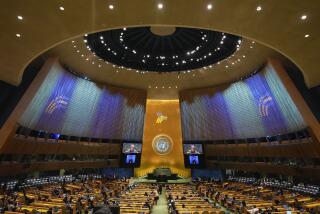50 Heads of State to Gather : Security Intense for U.N. Session
- Share via
NEW YORK — When the United Nations celebrated its 15th anniversary 25 years ago, Cuban Premier Fidel Castro threatened to camp in Central Park, Soviet Premier Nikita S. Khrushchev held news conferences from the balcony of the Soviet mission, and Gerard J. Kerins was just another police sergeant assigned to 1st Avenue near U.N. headquarters.
It was a historic security challenge for Kerins and 1,100 New York police officers as they guarded 26 foreign heads of state and their ministers. But Kerins and his fellow officers learned that history is written in small letters. In retrospect, Kerins says, “If there was one thing that stood out in my mind about the whole thing, it was boring.”
Biggest Gathering of Leaders
Now, Kerins, 61, has returned to the streets outside the United Nations, and his task is anything but tedious. As an assistant chief, he is directing police security for the 40th anniversary of the United Nations--the largest gathering of world leaders that New York City or the United Nations has known.
It poses the biggest security problem since the Olympics. By the time protective measures reach their height in three weeks, when President Reagan meets in New York with leaders of five major industrial nations in preparation for his November summit session with Soviet leader Mikhail S. Gorbachev, police and federal agents are expected to have provided security for almost 50 heads of state and 159 foreign ministers.
More than half of the Secret Service’s agents nationwide have been committed to the effort, in addition to 1,000 agents from other federal agencies.
The protective screen is immense and very much in evidence as diplomats attend General Assembly sessions. Quick-moving motorcades and traffic jams are already common in midtown Manhattan.
Massive Tie-ups Expected
Police predict massive tie-ups on some streets when Reagan speaks at the United Nations in conjunction with his pre-summit meeting. The movement of dignitaries to conferences, dinners and receptions will cause major delays as temporary roadblocks are set up. Highways may be closed as motorcades speed to and from airports.
Preparations began months ago when a blue-and-white police helicopter hovered over the 18-acre United Nations complex and nearby Waldorf-Astoria Hotel, photographing buildings and streets that many motorcades will follow. Computers to keep track of delegates’ schedules and demonstrations were later installed in one of three mobile police headquarters on 1st Avenue, opposite the United Nations. Even before the first diplomats arrived, police launches with heavy weapons began patrolling the East River.
Other police officers swept the shore of Roosevelt Island to ensure that there would be no repetition of the events of Dec. 11, 1964, when anti-Castro Cubans fired a bazooka at the U.N. building as Che Guevara, Cuba’s industry minister, was speaking there. The shell fell 200 yards short.
24-Hour Police Patrols
Terrorist technology has changed dramatically since then. Weapons have become smaller and more powerful. Explosives have become easier to detonate by remote control. Among other countermeasures, police have assigned around-the-clock patrols to 1st Avenue and to East River Drive alongside the United Nations to guard against car bombings, and barricades are now a permanent feature in front of the United States Mission to the U.N.
The spectrum of those who might stage disruptive demonstrations also has shifted. In addition to anti-Castro Cubans and Croatian terrorists, police now give extra attention to demonstrators who fled Afghanistan, Moslem extremists and protesters against South Africa’s apartheid policies.
“In 1960, we had the Hungarians to worry about,” Kerins said, “and the Cubans always pose a problem. A lot of the people from Afghanistan are very bitter about their country being taken over. We are in an unusual position. Anything that happens anywhere in the world that inflames peoples emotions has a bearing.”
Security problems will grow if Castro or Col. Moammar Kadafi of Libya, whom Reagan has denounced as a terrorist, attends the United Nations. Kadafi announced plans to come to New York, but unrest at home forced a cancellation, U.N. sources said. The sources said that Castro’s visit was uncertain.
U.N. Has Own Guard Force
New York’s police force, with 26,000 officers, will provide the chief security shield outside the United Nations. Inside the U.N. gates, protection is the responsibility of the organization’s 300 uniformed guards and investigators. Additional guards were brought in from U.N. facilities overseas for the session.
In 1960, police and federal agents kept track of the movements of all 26 heads of state on a series of blackboards set up next to an operations desk at police headquarters. Bits and bytes have since replaced chalk and erasers. Computers keep track of delegates’ schedules, police deployments and intelligence from federal agencies.
The computer network has been supplemented with extensive television surveillance. Cameras have been mounted at areas designated for demonstrations near the United Nations and other sites. Police have six hand-held cameras that can be transported to incidents to send television pictures to commanders at police headquarters.
Police Using High Tech
“We have gone in for high tech to coordinate all the information,” Kerins said. “We’ve started to bring microcomputers into the field to get a more detailed account of what is taking place.”
The depth of security was shown the other day when Secretary of State George P. Shultz was at the United Nations. A helicopter spotted something suspicious at an open window of the United Nations Plaza Hotel across the street. Officers were sent to the hotel to investigate.
Previous photo reconnaissance provided pictures of the hotel’s facade to police commanders who coordinated the floor-to-floor search until the precise window was found. Relieved officers found no problem but said the incident shows just a few of the resources that can be summoned when trouble is suspected.
More to Read
Sign up for Essential California
The most important California stories and recommendations in your inbox every morning.
You may occasionally receive promotional content from the Los Angeles Times.













